
Across the street from the Lake Elmo Airport, the second-smallest airport of the Metropolitan Airports Commission’s “reliever airports” — a neighborhood is rising from the onetime cornfields.
That’s significant given that the airport is becoming the focus of neighborhood opposition because of plans to expand one of the runways to a length similar to those at other small airports in the area, such as South St. Paul’s Fleming Field.
“Lake Elmo (Airport) is literally surrounded by residential, not commercial property like all of the other airports,” resident Maria Appelt said in a Stillwater Gazette article this week about residents taking their concerns to the Legislature.
“They (Metropolitan Council) have already said Lake Elmo needs to grow, and this seems to be in opposition to that,” Appelt said. “We have never been opposed to safety, but what do you need to have a safe airport?”
One might argue — as I’m arguing now — that one answer is not to build houses next to an airport.
But it’s too late for that solution. Sprawl is on the march in Lake Elmo, famous for its long-standing opposition to growth.
The city has thrown in the towel on preventing it, and farmers and other property owners are cashing in on the most profitable crop they’ll ever grow — houses.
“I have never seen a group so organized and so intelligent,” state Sen. Karin Housley, R-St Marys Point, told opponents of the plan when asked if she’d meet with the Metropolitan Airports Commission members who’ve advanced the plan in the face of their opposition. “I will help you with whatever you need help with.”
What might be the solution? Time, perhaps.

Speaking last Saturday to a group of mostly-graying pilots, the head of the largest association representing general aviation (that is: non-commercial aviation) presented daunting statistics showing a continuing decline in the number of licensed pilots.
Mark Baker, a Minnesota native and CEO of the Aircraft Owners and Pilots Association, said the number of new pilots each year pilot population has dropped 65 percent from the 1980s. From 827,000 active pilots then, the nation is down to 593,000 now, according to the AOPA.
Baker is embracing a series of proposal in Congress that would, among other things, simplify medical certification, but that’s an area generally of more concern to older pilots rather than younger people.
That reality, coupled with the unstoppable march of suburban sprawl, is dooming small airports all over America to shopping malls and housing tracts.
Archive: As Eden Prairie grows, an airport tries to get along with neighbors
